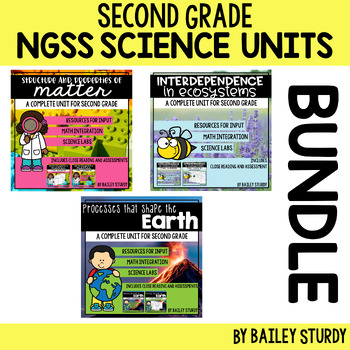2nd Grade NGSS Science Unit Bundle
- Zip
Products in this Bundle (3)
Bonus
Description
This bundle includes all 3 NGSS science units for second grade! It includes resources for reading, writing, math, as well as science labs for each unit.
In this bundle you will find:
Resources for Input
- Inquiry Charts
- Observation Charts
- Big Book (PPT or printable)
- Pictorial and Comparative Input Chart templates (17 total)
- What is Matter?
- States of Matter Pictorial
- Observable Properties Pictorial
- Chemical Reactions Comparative Input
- Biotic vs Abiotic Components Comparative Input
- Relationship in the Ecosystem
- Plant Needs Pictorial
- Habitat Pictorials: coral reef, desert, tundra, rainforest, wetlands, woodlands
- Earth's Layers Pictorial
- Quick vs Slow Events on Earth
- Maps as Models Pictorial
- Solutions for Erosion
- Chants (10 total)
- Five Properties of Matter (song)
- Properties Here, Properties There
- Disassembly Sound Off
- Changes? Yes, Ma'am!
- Ecosystems Here, Ecosystems There
- Relationships in the Ecosystem? Yes, Ma'am!
- Habitats and Ecosystems (song)
- Geology Bugaloo
- Erosion Here, Erosion There
- Maps Sound Off
- Chants (10 total)
- Sentence Pattern Charts (printable student copies, teacher samples)
- Expert Group Texts:
- Properties of Matter (set of 6)
- Types of Changes Mini Passages (set of 6)
- Habitats (set of 6)
- Pollinators and Seed Dispersers (set of 6)
- Landforms (set of 6)
- Continents (set of 7)
- Mind Maps to go with Expert Group texts
- Process Grids to go with Expert Group texts
- Writing Prompts for Narrative, Informational, and Opinion text types (9 total)
Math Integration -- 12 activities total. Titles are:
- Magnetic Addition Patterns (center: odd/even numbers)
- Place Value Race (game: add or subtract 10 or 100)
- Graph, Spin, Answer (center: create graphs)
- "Array"nging the Pieces (center: array puzzles)
- Graphing Biodiversity (center: create graphs)
- Number Line Dispersal (center: match number lines to equations)
- Input and Output Animal Homes (center: solve for missing numbers)
- Fluency: Which Does Not Belong? (game: be the first to find the math fact that doesn't match)
- Landform Line Plot (center: make a line plot)
- Around the World (center: compare numbers)
- Measurements on Earth (center: match word problems to answers)
- Share the Planet (center: sort shapes to match fraction names)
Science Labs -- 16 total. Each lab comes with teacher directions, materials lists and tips. Titles are:
- Root Beer Float Lab
- Property Sort and Build
- Absorbency Lab
- Assembly Line
- Rock Candy Reverse
- Ice Cream, You Scream!
- Habitats Multimedia Text Set (digital activity)
- Plant Needs Investigation
- Seed Dispersal Design Challenge
- Ecosystem in a Bottle
- Pangaea Puzzle (digital or print)
- Landforms and Bodies or Water Puzzles
- Events on Earth Exploration (digital multimedia text set)
- Erosion Investigation
- Where is our Water? (demonstration)
- Earth Models (2 options: make a map or globe to represent land and water on the Earth)
Art
- Printables of works of art
- Guiding Questions to connect art and science
- 1 Art Lesson per Unit
Assessment
- Ecosystems Assessment: 22 Questions + Answer Key
- Matter Assessment: 19 Questions + Answer Key
- Earth Science Assessment: 16 Questions + Answer Key
NOTE: Assessments are available separately. If you buy the units, there is no need to buy the assessment as well. The assessments are included in the units.
Close Reading
9 sets total, each including:
- Essential Question
- Informational Text (at 3 levels, in both reader and article format)
- 3 CCSS/DOK Aligned Question Sets
- Journal Prompts (for EQ or DOK 4)
- Titles:
- How Do Gemologists Measure Luster?//Hardness? (paired texts)
- The Structure of Gems
- How Gems Form
- The Kelp Forest//Grasslands (paired texts)
- Weird Seeds and How They Move
- Aquaponic Farms
- The Hawaiian Islands//Mt. St. Helens (paired texts)
- Pangaea: The Supercontinent
- Water World
These close readings are available digitally as Google Slides presentations. Within each close reading PDF, there will be a chart with links for presentations with each leveled text, question sets, and journal prompts of the titles.
Note: These are the same close readings in the 2nd Grade Close Reading Bundle and the individual close readings. (Habitats, Earth's Processes, and Matter)
BONUS: The unit includes proficiency scales for each NGSS standard to help you and your students know exactly what they're learning. These are a helpful tool for standards based report cards and conferences! The proficiency scales are only included with the NGSS Unit bundle!





